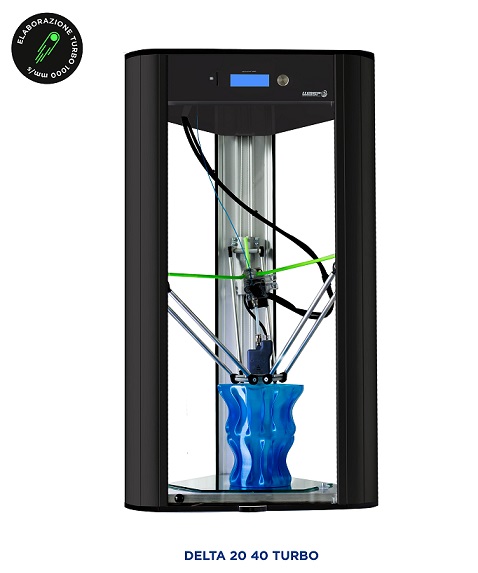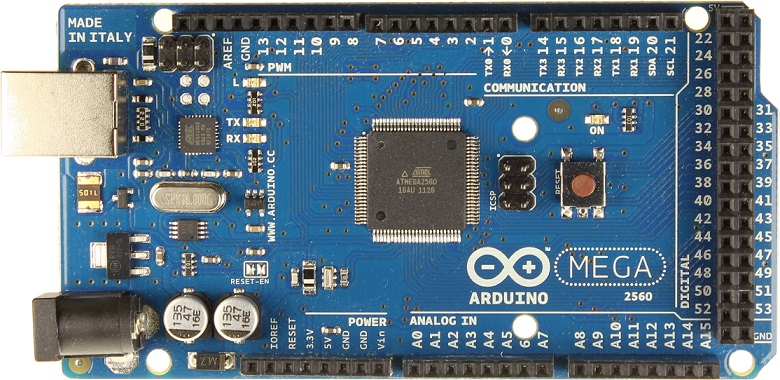The DeltaWASP becomes TURBO
The DeltaWASP becomes turbo and is a candidate to be the fastest in the world. WASP will present DeltaWASP 20 40 Turbo version to 3D Print Hub of Milan. Already one of the fastest printers available, this model is the first to touch the 1000 mm/s.

The group, which is continuing its research and design of BigDelta (the printer, several meters high, designed to make homes with material at km. 0) has identified the need of a more powerful card to move the arms of the motor with a speed adequate and with a fluidity greater. This need has started the new project of WASP: Changing the program that controls printers (Marlin), in order to manage a board redesigned with a 32-bit RISC processor and 82 million operations per second.
“In the world of open source we have not found the most powerful cards: All firmware is written for Arduino Mega. This has forced us to take a deep work of discovery and development that we share in open source to reciprocate the valuable knowledge that we have been donated by the community until now, “says Massimo Moretti, founder of WASP.
Waspers have tried the “enhanced” board on a solid printer, the DeltaWASP 20 40. The result was amazing: with the Turbo implementation, now the machine can reach up to 1000 mm / s, so is a candidate to be the world’s fastest FFF printer. Thanks to the characteristics of the Delta, including the extruder amortized, the unique design of the integrated guides in the structure and the cooling turbine and conveyed stream which distinguish it, the accuracy remains unchanged.
The discoveries in the WASP house are practically monthly. As always, the group reinvests in research almost all of the proceeds of their sales. That of WASP is an Italian excellence, which actively contributes to knowledge sharing and spread of tools accessible to most people, with the intent to allow, through 3D printing, to start a real production.
The invitation is in Milan, 5, 6, 7 March to see the work the fast printer whole Italian WASP.
Our path to DeltaTURBO
Building the BigDelta to print houses we ran into a problem that we had never met before: the control board (Arduino Mega) could not easily handle the amount of data required to move the axes of the engines.
It seems impossible that a processor which controls 16 logic states with a speed of calculation of 16 million cycles per second, for a total of 256 million operations, is not able to control a mechanics.
That electronics is put into crisis by mechanics is generally unlikely.
On closer inspection, however, a printer Delta should run about 200 square roots to the millimeter for each axis (and the axes are 3, without considering the extruder). We realized that the Delta configuration requires a huge amount of data to be run and that was why the BigDelta, meters high, proceeded in spurts and delayed to update the display, turning the encoder board did not respond.
Unfortunately in the world of open source we have not found boards that would meet our needs: those who have developed does not share them and find a firmware to manage more complex processors is not pooling. In the open world there are valuable suggestions, but few solutions for professional applications.
Get out of the shared knowledge is hard, we are sailing the open sea, where no one has ever sailed. But we had to.
WASP has in its team Dennis Patella, a great innovator, ready to “eviscerate” the Marlin (the program that controls printers) and reassemble it skilfully. The challenge was really hard, like the ones that we like: a 32-bit RISC processor and 82 million operations per second, for a total of 2.624 billion operations per second can do what they do 10 processors old mode
The work ahead is great: these processors are fed to 3 volts to avoid overheating and energy waste, then the driver of the motors must be resized, so the mosfet control devices and references of the analog-to-digital comparators.
But when the game gets hard a Wasper does not hold back, in fact, is on the battlefield that gives the best of himself. So Dennis, Roberto and Massimo have redesigned the board and have it mounted on a 20 Delta 40.
As it had already happened for Resurrection System, the research was aimed at resolving problems arising from BigDelta to focus then on solid commercial printers with relatively small size.
[vsw id=”1LDlMcy22Z8″ source=”youtube” width=”425″ height=”344″ autoplay=”no”]
The DeltaWASP 20 40, agile and robust as it is, has adopted the computing power of the new board, making all amazed: printing proceeded at an unimaginable speed and moved alarmingly, we all wondered if it would hold up silently, or would explode.
The battle between mechanics and electronics was in place: increased speed, acceleration grew by 150%, 200%, 300%, 400%, 500% … from 3,000 mm / s² to which we were accustomed to 5,000, 10,000, 20,000 mm / s².
The DeltaWASP 20 40 handles millions of data per second and executes them perfectly, without blinking, or better, without losing steps. Seems to flap its wings and take flight.
The green rubber bands that distinguish our outstanding extruder suspended, vibrate. It is hard to see the same extruder. It is the structure of DeltaWASP and in particular the outstanding feature of the extruder (protected by Creative Commons) to allow such a result. Movement speed up to 1000 mm / s and acceleration up to 20,000 mm / s². The enthusiasm skyrockets, when we realize that it is one of the fastest printers in the world, indeed, is perhaps the fastest.
If you are interested in firmware, software and various documentation about WASP 3D printers I recommend you visit this page.[:]


